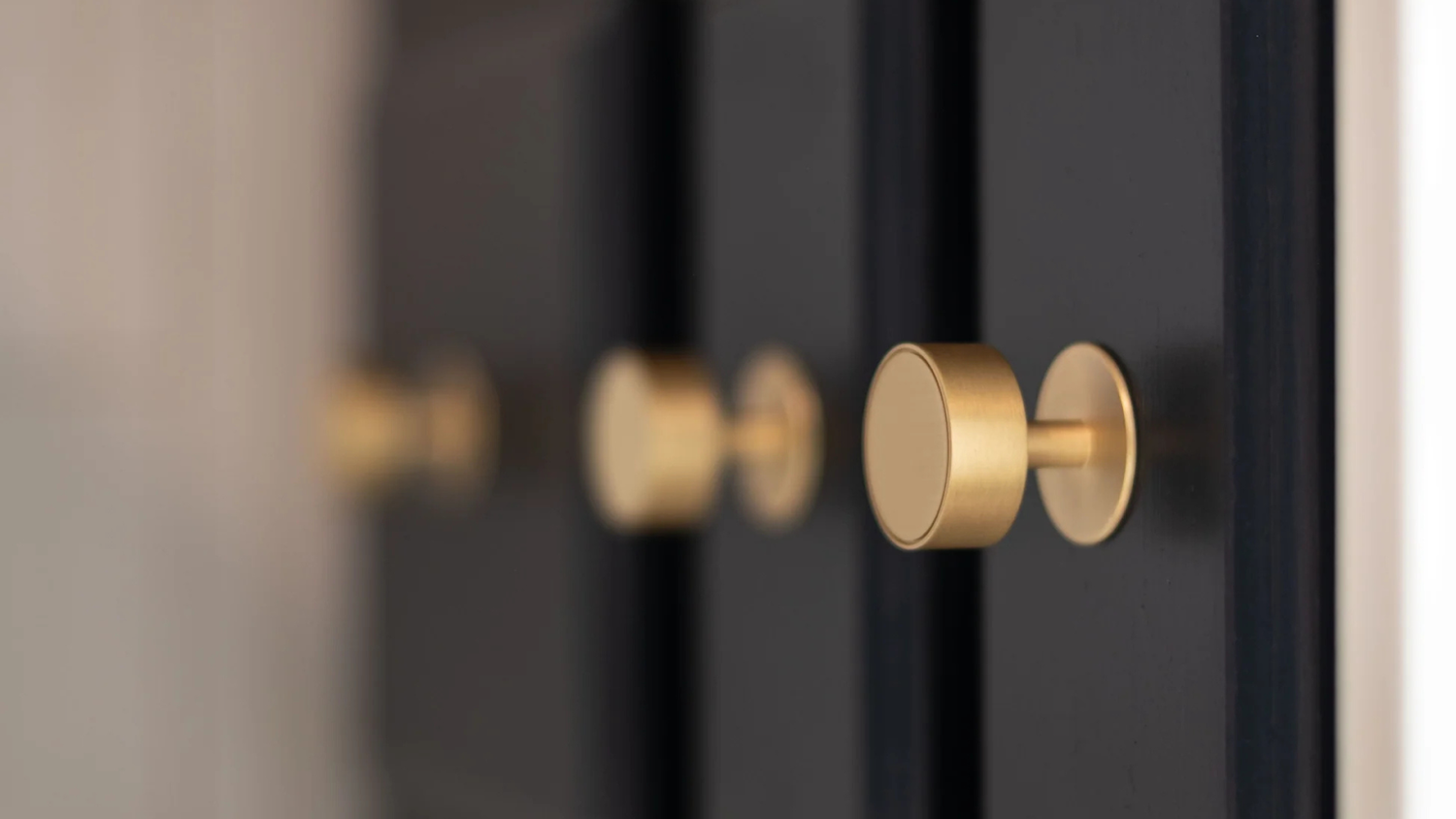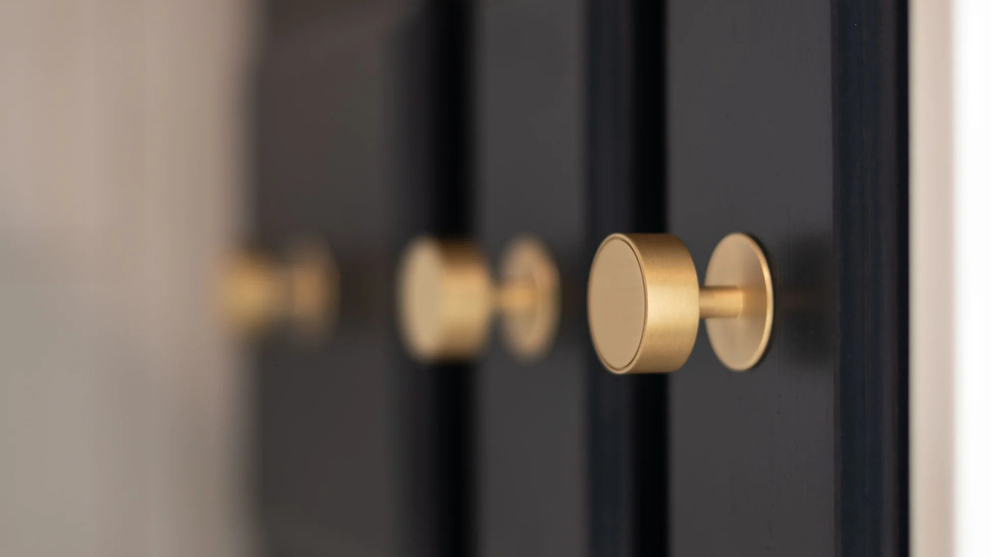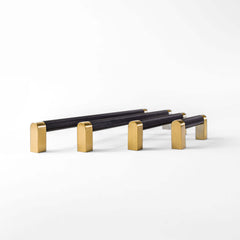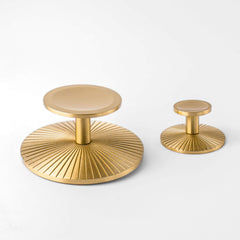Key Takeaways:
- How Brass Changes Over Time: Brass evolves with its surroundings. Over time, exposure to air, touch, and moisture encourages a shift from bright shine to soft patina. While some darkening signals natural character, uneven tarnish may call for gentle cleaning or protection depending on the finish.
- Why Brass Oxidizes Faster in Kitchens and Bathrooms: In high-touch spaces filled with warmth and humidity, oxidation speeds up. Daily exposure to water, skin oils, cleaning products, and airborne particles creates conditions where brass tarnishes easily, when unsealed or frequently handled.
- How to Keep Brass Fingerprint-Free and Clean: Gentle care makes all the difference. A soft, dry cloth after use can lift oils before they leave marks. Pantry staples like baking soda, vinegar, or lemon offer safe ways to clean without damaging the surface.
Picture sunlight filtering through your kitchen window, catching the golden curve of a cabinet pull that sparkles like the first day you found it. It’s elegant but grounding, modern yet utterly timeless. But for everyone who has stood in a showroom, eyes resting on a gleaming brass handle, one question returns: Does brass tarnish?
Shortcuts often win out, but brass is an honest material; beautiful, yes, but vulnerable too. It reacts and evolves. That’s part of its allure, and a key reason why so many designers and homeowners obsess over finding the right finish for spaces that matter. In this guide, we’ll untangle the nuances of brass: why it tarnishes, what that transformation means, and how to choose finishes that’ll remain as true to your interior design vision.
How Brass Changes Over Time: Patina And Tarnish
Brass tells its story in layers. The question does brass tarnish easily is often the beginning of a deeper conversation about how brass evolves, from radiant and smooth to richly marked by use. Two outcomes define that evolution: patina and tarnish. They may look similar at a glance, but their meaning, their texture, and their emotional resonance couldn’t be more distinct.
When Patina Is the Point
Patina is brass’s version of a memory. It builds slowly, softening edges and deepening color in response to everyday life. As brass interacts with air, humidity, and the gentle press of your hands, it develops olive-toned shadows and honey-bronze highlights. These changes settle across the surface gradually, revealing a lived-in beauty that doesn’t mask the material but brings its complexity forward.
Many design lovers seek out this kind of aging, as they’ll let a cabinet pull tell the story of years spent in a bustling kitchen or leave a drawer knob unpolished to gather a quiet warmth over time.
Tarnish: The Harsher Transformation
Tarnish speaks with a different tone. Caused by oxidation, when brass meets moisture, skin oils, or airborne pollutants, tarnish resembles cloudy patches, dark streaks, or green-tinged spots that dull the glow rather than enhance it. While solid brass hardware is built to last, even the most carefully crafted finishes may shift without regular care.
Tarnish can sometimes feel intrusive, asking for attention where patina feels earned. A light polish may restore clarity, but deeper blemishes might call for a more involved treatment. Still, even this less poetic transformation reminds you that brass is alive.
Why Brass Oxidizes Faster In Kitchens And Bathrooms
Brass shines brightest in the spaces we use most. Kitchens and bathrooms hold that rare tension between beauty and practicality—both essential, both ever in motion. These rooms expose hardware to moisture, friction, temperature shifts, and product residue that can quietly shift the metal's surface over time. Let’s uncover why brass tends to oxidize faster in these spaces.
Moisture And Humidity Are Constant Influencers
Warm water, rising steam, and subtle shifts in temperature linger long after you’ve turned off the tap. In a sunlit kitchen filled with the hiss of boiling water or a bathroom wrapped in post-shower fog, brass can absorb moisture from the air without ever being touched. This low-level exposure speeds oxidation, encouraging brass to shed its initial glow for a deeper, more muted finish. Even the smallest bead of condensation, from a nearby kettle or sink, can start to reshape how brass looks. Additionally, in climates with naturally high humidity, the evolution moves more quickly when finishes remain unsealed.
The Daily Touch: Skin Oils, Soaps, And Surface Cleaners
Our hands carry traces of everything we’ve used that day. Lotion, shampoo, facial toner, and cleaning spray; all of it leaves a residue on hardware that reacts with brass on contact. Over time, those natural oils and commercial formulas can act like accelerants, speeding the darkening process and softening the metal’s clarity.
This is why cabinet pulls in bathrooms or kitchen drawers tend to develop a lived-in glow much sooner than those in other parts of the home. Every touch becomes part of the finish’s journey, layering in softness and story. For more ideas on how to layer in warmth through aged brass finishes, explore our feature on bringing warmth to bathrooms with antique brass fixtures.
Certain Cleaners Break The Surface Barrier
Even mild cleaning sprays can leave a mark over time. Acidic bathroom cleaners, bleach-infused formulas, or overly abrasive wipes can compromise protective lacquer, allowing moisture and oxygen to reach the brass beneath. Once that surface seal is worn down, oxidation moves faster and less predictably. Even cleaners marketed as “gentle” can contribute to a dulled appearance when used too frequently or without rinsing. A simple wipe with a soft, dry cloth does more for brass longevity than many commercial products combined.
Airborne Compounds Play A Quiet Role
While less obvious, particles in the air still leave a trace. Sulfur compounds, common in urban pollution or coastal regions, can deepen brass tones. So can leftover chlorine from cleaning supplies, or any number of microscopic elements that drift through open windows or HVAC systems. Over time, these airborne factors add dimension to brass in the form of uneven darkening or rich undertones.
How To Keep Brass Fingerprint-Free Without Losing Its Warmth
Brass invites touch, yet constant contact leaves behind traces: fingerprints, smudges, and streaks that can soften its shine over time. With a few simple habits, designers and homeowners can keep brass looking luminous without interrupting its natural charm.
- Use a soft microfiber cloth for daily upkeep: After handling hardware, reach for a dry cloth to remove skin oils and moisture. This small ritual prevents buildup in high-touch areas like vanity knobs and kitchen drawers. Avoid paper towels or textured cloths, which can leave fine scratches behind.
- Introduce warm water sparingly for deeper smudge removal: When prints begin to build up, a lightly dampened cloth can lift more stubborn marks. Warm water loosens surface oils, but brass doesn’t welcome lingering moisture. Always dry hardware immediately with a plush cloth to protect the finish.
- Skip the chemicals: Household cleaners with bleach, acid, or abrasive grit can damage both lacquered and unlacquered brass. Over time, these products can strip protective layers or etch the metal itself. Stick to gentle methods, and let brass age at its own pace.
- Apply a whisper-thin layer of brass polish: For unlacquered brass in high-use spaces, a barely-there layer of clear wax or polish creates a protective shield. It softens the appearance of fingerprints and slows oxidation while still allowing the brass’s natural tone to show through.
- Match your care routine to the finish you’ve selected: In high-traffic rooms where you’ve chosen unlacquered hardware, like our solid brass half moon cabinet pulls, routine touch-ups can keep the surface balanced. A satin or aged finish already invites patina, so minor spots may blend in beautifully without demanding polish.
Safe Cleaning Solutions That Live In Your Pantry
Brass, with its warmth and luster, can lose its glow over time. Before you rush to specialty polishes, take a look at your kitchen. Some of the safest, most effective cleaning solutions for tarnished brass are humble pantry staples: baking soda, vinegar, and lemon. Below are some easy, low-impact cleaning methods that let the texture and tone of solid brass hardware remain front and center.
Baking Soda: A Soft Abrasive With Steady Results
For those drawn to quiet transformations, baking soda is the go-to. Combine a small amount of baking soda with water to form a paste, then use a soft, damp cloth to massage the mixture into the tarnished surface. This method lifts oxidation without leaving behind harsh scratches or dull patches. The result is a surface that gleams softly rather than glaringly; perfect for pieces that have already begun to develop a rich patina.
White Vinegar: A Quick Soak That Respects The Finish
When hardware needs a deeper refresh, vinegar offers a balanced solution. Mix equal parts white vinegar and water in a small bowl, then submerge the hardware for a few minutes. After soaking, buff gently with a microfiber cloth. This simple process removes lingering residue and dullness while allowing the existing character of aged brass to remain intact. Vinegar’s natural acidity breaks down surface grime without overpowering the material beneath.
Lemon and Salt: Brightening Brass With Freshness and Texture
Lemon delivers citric power and gentle friction. Cut a lemon in half, dip the exposed side in fine salt, and rub the mixture across the brass surface. This blend works particularly well on darker tarnish that’s developed unevenly across a high-touch area. After cleaning, rinse the piece with warm water and dry it completely using a soft, plush cloth. The process leaves behind a glow that feels fresh, but never too polished.
Final Thoughts
Brass is a metal that tells a story with time. The surface may shift, the glow may soften, but those changes reveal something genuine. In a world filled with perfect-sheen imitations, the deepening color and quiet warmth of patina offer presence and personality. Every fingerprint becomes a brushstroke. Every season leaves a mark that feels honest, earned, and beautifully lived in.
Our team at Inspire Hardware designs with that transformation in mind. Each piece reflects a balance between glow and grit—hardware that evolves with you and becomes part of your space’s rhythm. For those drawn to the radiance of fresh finishes or the richness of aged surfaces, our solid brass hardware meets the moment.
Read more:
- A Step-by-Step Guide to Painting Kitchen Cabinets Like a Pro
- The Different Types Of Cabinet Hinges And How They Work
- Modern Kitchen Ideas: 10 Cabinet Designs for a Fresh Look
Frequently Asked Questions About Brass Tarnishing
Is tarnished brass a sign of poor quality?
Tarnish does not signal inferior craftsmanship. Tarnishing is a natural surface reaction, not a flaw in the material. A soft patina can become one of brass’s most beautiful features, revealing its organic depth and reflecting the rhythm of daily life. At Inspire Hardware, our solid brass hardware is crafted to resist uneven wear while retaining its distinctive glow.
Does solid brass tarnish at the same rate?
Not exactly, tarnish develops differently based on where the hardware lives. Brass in a breezy kitchen may age gently over time, while hardware near a steamy shower or coastal breeze may develop darker tones sooner. Hand-applied finishes and textural details, like those found in our orbital solid brass cabinet pulls in assorted finishes, also create subtle differences in how each piece evolves.
What causes brass to tarnish faster?
Moisture, salty air, oils from fingertip touch, and exposure to household cleaners or acidic foods can accelerate tarnishing. Kitchens and bathrooms, those lively, ever-changing spaces, can nudge brass to reveal its golden-age stories more quickly. Likewise, frequent handling adds warmth and fingerprints, hastening the development of a soft patina.
Can brass tarnish be avoided altogether?
Brass naturally changes over time, but you can slow that evolution with a few gentle habits. Wipe hardware with a soft, dry cloth after use. Avoid harsh sprays, and keep surfaces dry between cleanings. For those who prefer a bright, lasting gleam, lacquered options provide added protection. For others, the gradual darkening of unlacquered brass offers a richness that grows with the space.
Does lacquered brass resist tarnish better?
Yes. Lacquered brass includes a transparent finish that shields the metal from oxidation. This added layer makes it an excellent option for areas that see frequent use or high humidity. Our lacquered designs offer clarity and consistency while preserving that golden warmth brass is known for.
Does touching brass with bare hands cause it to darken?
It can. Skin oils, lotions, and even moisture from your fingertips encourage oxidation. This is why frequently handled brass hardware often develops a soft patina more quickly. A quick wipe with a clean cloth can slow the process without interfering with the finish’s natural character.
How long does it take for brass to tarnish?
Tarnish doesn’t follow a fixed timeline. In some spaces, especially humid kitchens or baths, brass may begin to darken within months. In others, it can remain bright for years with minimal care. Each piece tells its own story—from luminous beginnings to richly aged finishes. Explore how this transformation adds depth to our pieces, like the strike-hammered brass cabinet knobs, while they’re still available.







